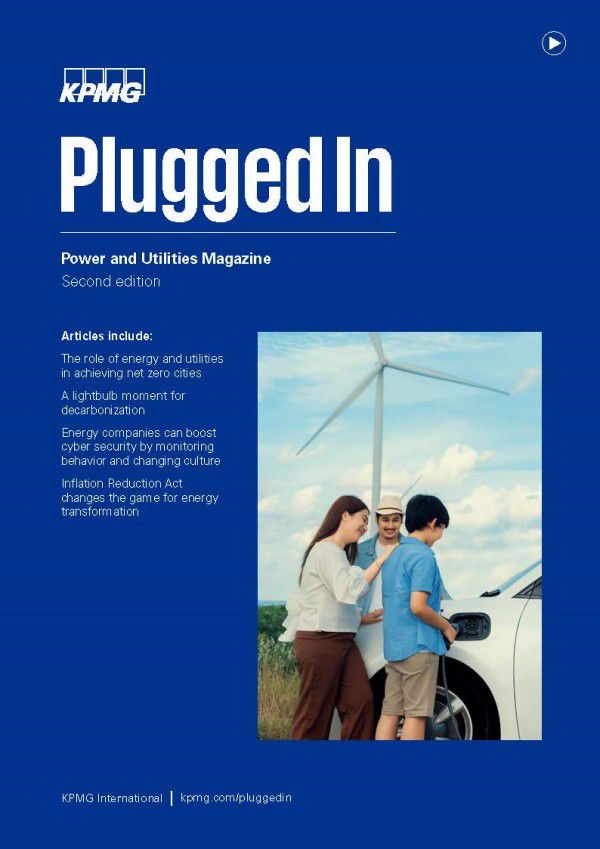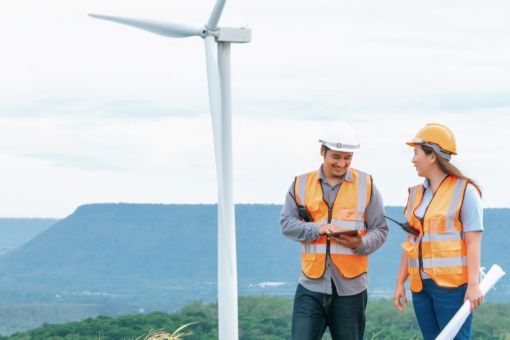Climate change and energy security pose a high current and future global risk that requires urgent action. Meeting global targets will require macro and microeconomic transformation, led by fundamental business model changes for public and corporate organizations. Understanding and planning for the likely implications of decarbonization will be crucial in meeting increasing pressure from consumers, employees, investors, lenders and governments. An example of such governmental pressure is the European Union (EU) Green Deal and, more specifically, its Energy Efficiency Directive and Renewable Energy Directives, which call for at least a 32.5 percent improvement in energy efficiency and for renewable energy to make up at least 32 percent of power usage in the EU, both by 2030.1
As of March 2021, at least 20 percent of the world’s 2,000 largest public companies have already made net zero commitments, and many others will follow.2 Despite more companies recognizing the need for climate commitments, less than 1% of companies have disclosed against all 21 key indicators that constitute a credible climate transition plan.3 Significant efforts to reach these commitments will need to be made around energy. Energy use accounts for nearly three-quarters of all greenhouse gas emissions globally, with industrial energy use accounting for around one-quarter.4 Improvements in energy efficiency alone could significantly reduce global emissions and energy needs, with research suggesting that United States emissions could be halved by 2050 through such work.5 To fulfill climate commitments and optimize operations, organizations should identify strategies to translate their goals and plans into action. A strategic approach to energy management can be beneficial as it allows organizations to decarbonize while also achieving potentially substantial energy and cost savings, which is particularly crucial in a time of high and volatile energy costs. In this scenario, KPMG firms have been helping clients using Strategic Energy Management (SEM) which operationalizes energy efficiency across their portfolio of facilities.

Plugged In
The role of energy organizations in combating climate change
Download magazine (2.46 MB) ⤓
Aims and advantages of SEM

SEM is a holistic continuous improvement framework that enables organizations to adopt a culture of energy efficiency and decarbonization. This reduces energy consumption and costs and cutting scope 1 emissions from sources owned or controlled by the organization and scope 2 emissions from the generation of purchased electricity, steam, heating and cooling consumed.
SEM is based on three tiers of interventions that involve increasing investment levels and complexity. By working on each tier simultaneously, an organization can speed up the process of energy reduction and decarbonization
Approximately 5 percent of savings can be achieved annually through optimizing current assets in tier 1.6 These savings can be unlocked quickly, allowing teams to achieve further improvements across tier 2 by upgrading equipment, then tier 3, by implementing renewable energy. The benefits of adding renewable energy assets can be significantly negated if there are still ways to optimize energy consumption, such as running indoor lighting, heating or air conditioning at night or powering motors when they are not required.
Thinking strategically about energy
Most organizations are understandably focused on their core businesses rather than on the energy consumption of their activities, so SEM aims to 'piggyback' on existing initiatives and actions by integrating an energy efficiency mindset into everyday operations. SEM brings an organization’s prioritized facilities into a collaborative network or cohort and works with them using a structured approach to help adopt a continuous improvement process for energy management and efficiency. The process includes a series of group workshops, one-on-one engagements with each facility, and technical support designed to achieve the following objectives:
- Instilling organizational commitment by setting goals for savings at corporate and facility levels. Securing executive sponsorship leads to higher accountability, better allocation of resources at each facility to energy management activities and a robust governance model.
- Identify ‘energy champions’ at both corporate and facility levels, then build cross-functional teams around them with the support of executive sponsors. This can help enable groups to exchange knowledge and take responsibility for implementing SEM.
- Building a performance monitoring and tracking system based on relevant and detailed data tracking initiatives’ actual return on investment. Organizations can use this to track performance and identify opportunities for savings on a corporate, facility and equipment level.
- Establishing a long-term continuous and systemic improvement process that can identify, track, prioritize and implement energy-saving opportunities. These can relate to changes in behavior, improvements to processes or the installation of new and more energy-efficient equipment.
- Ensuring that energy-related targets are aligned with overall business objectives and goals, and decarbonization targets.
UK government-sponsored research has shown that implementation rates of energy efficiency projects are around 13 percent regardless of project costs and payback periods, but that sustained commitment to change can improve this rate.7 Therefore, setting up a structured approach which is backed by people at various levels within an organization is key to establishing change.
Successes in energy-intensive industries
SEM is a people-centered approach empowered by data and technical insights to drive behavioral or operational changes, educating employees about energy efficiency and how they can improve it through process and maintenance practices.
One gas infrastructure company that ran a two-year SEM program in a number of its plants found that low-cost and no-cost changes to processes and staff behavior saved both maintenance and fuel costs as well as cutting carbon emissions, improving the performance of some operating processes by around 30 percent.8 The changes also made the plants easier to operate and increased their uptime.
Focusing on improving the energy efficiency mindset across the organization ensures that implemented changes are followed-through. A construction materials producer that implemented SEM at two plants found it could change pump timers and lower the temperature of its natural gas-powered outdoor aggregate heating pads by a few degrees. Most importantly, the company used awareness campaigns/ engagements to remind employees to find energy savings, leading them to turn off equipment when not in use, including conveyor belts, motors, lighting and computer monitors. At one of the company’s sites, energy efficiency measures cut the use of natural gas per unit of production by nearly 25 percent.9
Such changes brought by SEM can be reinforced when they generate additional non-energy benefits. When equipment and assets operate more efficiently, they typically require less maintenance which saves on costs as well as reduces safety incidents. For example, low-energy LED lighting typically requires less maintenance than conventional lighting, offering both efficiency and safety advantages in facilities with difficult-to-reach locations.
How to get started with SEM
SEM enables organizations to strategically optimize their technologies, processes and people to improve energy efficiency and to decarbonize. Underpinned by active governance, stakeholder engagement, organizational change, project planning, risk mitigation and reporting insights, SEM is based on an iterative and continuous cycle of improvements across five key pillars:
1. Assess: at the initial stage, evaluating an organization’s maturity at a corporate and facility level and its decarbonization and energy efficiency ambitions is critical. This stage also involves benchmarking and prioritizing facilities based on energy use and carbon footprints, assessing data collection maturity and creating a monitoring and reporting deployment plan on a portfolio, facility, and significant energy user level.
|
2. Discover and plan: this stage identifies energy measures involving optimization, equipment replacement and renewable energy by using insights from the Assess stage with data analytics, reviews, and onsite energy scans/ audits. It also involves reviewing financing, tax, regulation and government policies, as it is often the case that energy efficiency and renewable measures are eligible for incentives and tax benefits. It then sets a prioritized short-to-long-term implementation plan and facility and business-wide targets that align with external objectives.
|
||
3. Implement: the critical components of this stage are program, project, change, data and performance management. It involves assigning responsibilities, particularly to energy and program managers, to ensure that they work with broader teams and take responsibility for putting the energy efficiency measures into practice. Implementation teams should be cross-functional and consist of approximately five to six people from operations, marketing and finance, and executive committee members to act as key sponsors across the entire organization. |
4. Build capability: as core teams are built, communication and engagement plans should be implemented to ensure that progress is shared company-wide, enhancing accountability. A cross-functional project team should be well-placed to look for changes that deliver energy efficiency, educate staff on how efficient work can have other benefits, celebrate an SEM program’s successes and share its best practices. Capacity building and cultural enablement also help and upskill staff to contribute to reaching the organization’s energy and decarbonization targets. | 5. Monitor and report: with control, monitoring and reporting systems in place, the organization has a better overview of both internal factors and progress, as well as external developments that affect the performance of the SEM program, providing better reporting insights.
|
|
In the first year of an SEM program, it is typical practice to work through one iteration of this cycle, with the first six months designed to generate early savings based on an energy and opportunity scan to identify optimization, low-cost capital and renewable-based measures that can be implemented at a fast pace. In the first year, organizing targeted workshops on areas including energy monitoring and modeling, performance tracking and how to engage the organization through employee events and activities will be essential. Given all these steps, it is key to note that SEM is a flexible approach that can be adapted to an organization’s maturity and needs and be combined with other decarbonization levers such as carbon offsets, circularity, and power purchase agreements.
In summary, SEM involves technical and engineering changes, but its main focus more comprehensive systemic organizational changes. Among the best ways to reduce carbon emissions and use energy with greater efficiency is to work with people to change business strategies, practices and processes, and KPMG is ideally positioned to support clients in achieving this.

How can KPMG help
In addition to our extensive experience in asset and organization transformation, tax, risk, policy, and financial management, KPMG's SEM programs offer several distinct advantages. With the support of our network, we can identify specialist organizations and work together to provide a customized approach to organizations while remaining agnostic.
In addition to the SEM delivery model, we work with preferred providers who offer energy monitoring and performance monitoring services. A variety of technical engineering companies can be selected based on the client's preferences and the sector they operate in. In addition, KPMG has the option of coordinating or implementing SEM engageme
Get in touch

Global Energy Institute
Receive valuable insights covering critical energy topics.

Follow us on LinkedIn
View regular energy content on our LinkedIn showcase page
Connect with us
- Find office locations kpmg.findOfficeLocations
- kpmg.emailUs
- Social media @ KPMG kpmg.socialMedia
Additional Thinking
1KPMG, Renewable Energy and Energy Efficiency Directives: European Parliament gives the greenlight, September 2022
2Energy and Climate Intelligence Unit and the University of Oxford, Taking stock: A global assessment of net zero targets, March 2021
3CDP, Are companies developing credible climate transition plans?, February 2023.
4Our World in Data, CO₂ and greenhouse gas emissions, emissions by sector, 2020
5American Council for an Energy-Efficient Economy, Halfway there: energy efficiency can cut energy use and greenhouse gas emissions in half by 2050, 2019
6Northeast Energy Efficiency Partnerships, The potential of strategic energy management to contribute to state decarbonization goals, 2021
7UK Department of Energy and Climate Change, Research to assess the barriers and drivers to energy efficiency in small and medium sized enterprises, 2014
8University of Alberta, Energy Efficiency Alberta
9ibid








